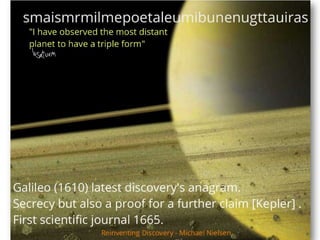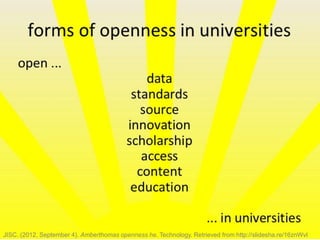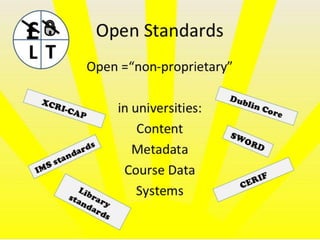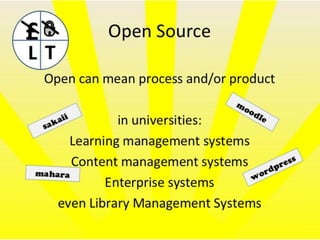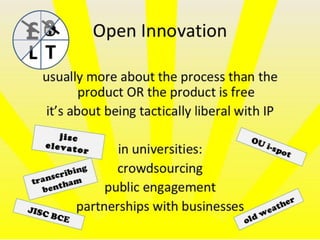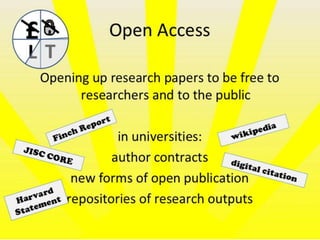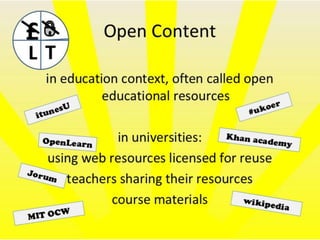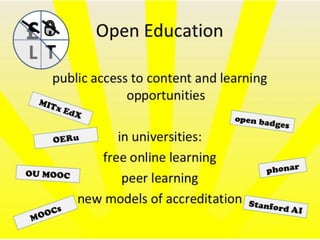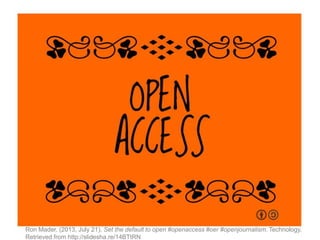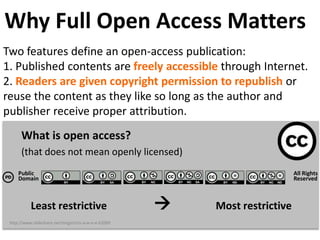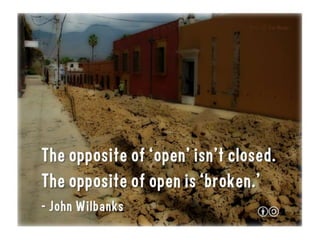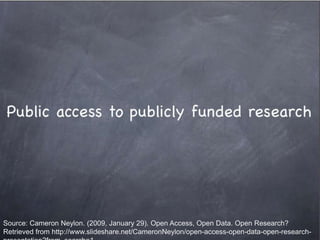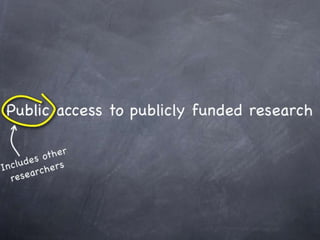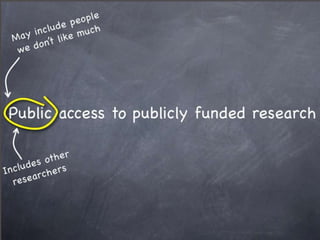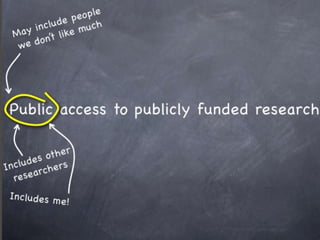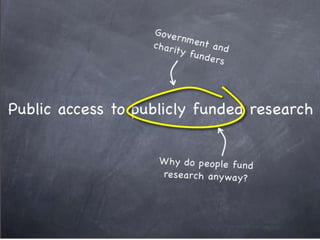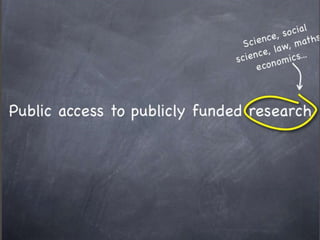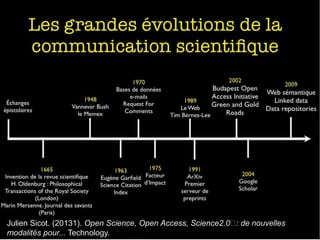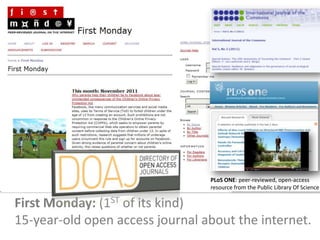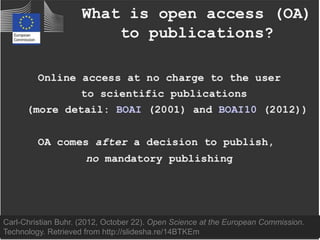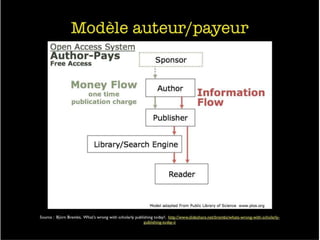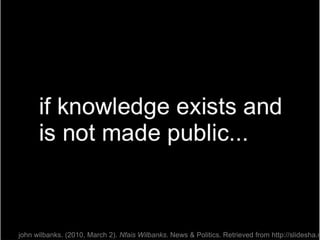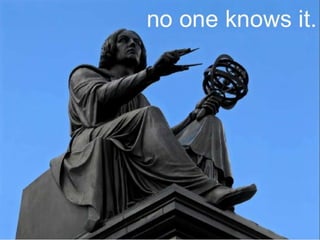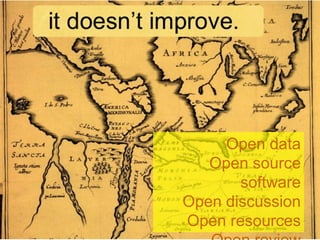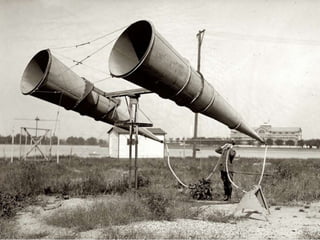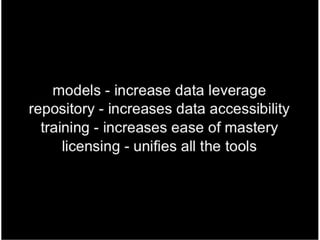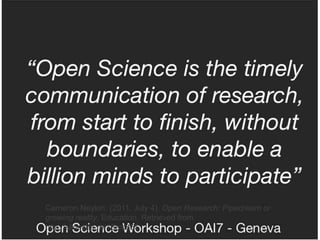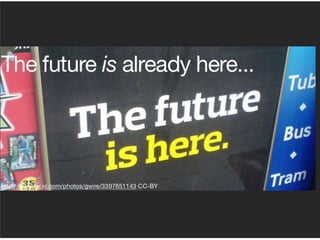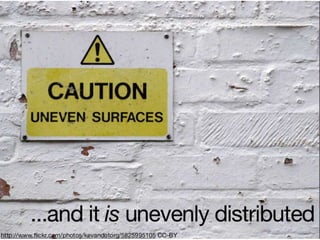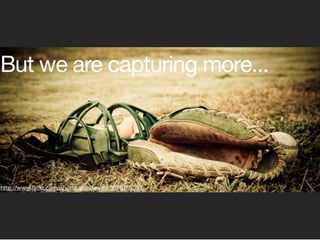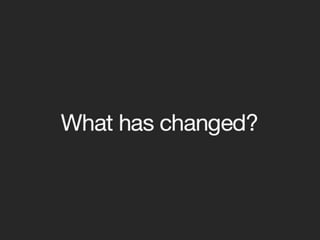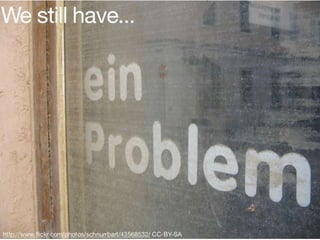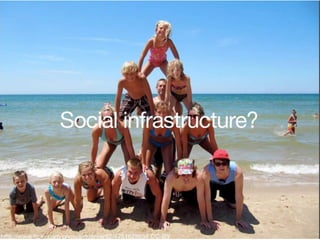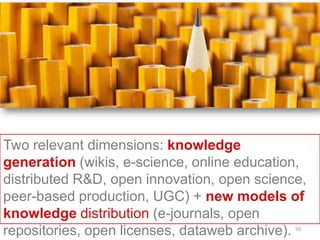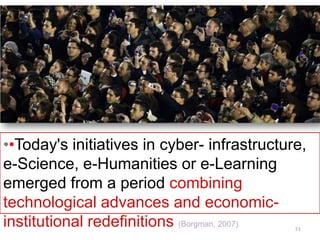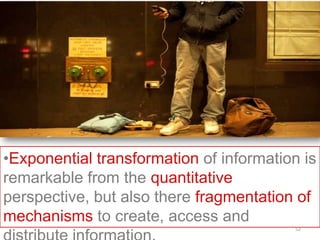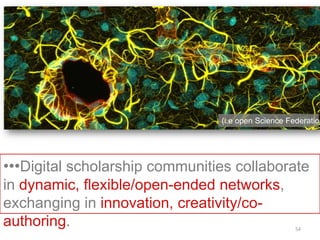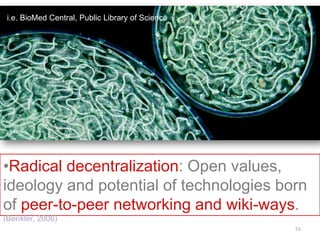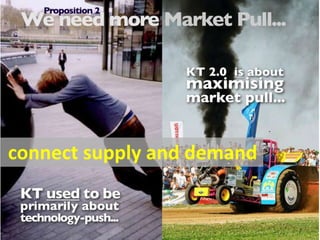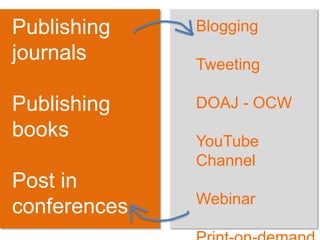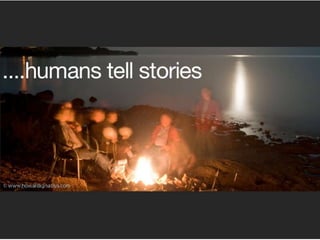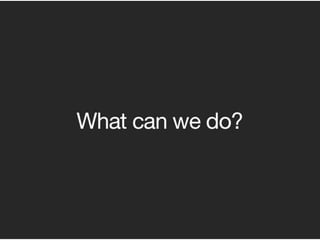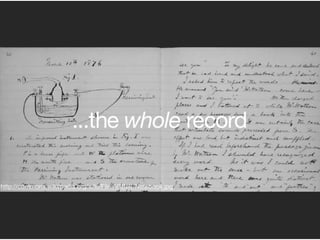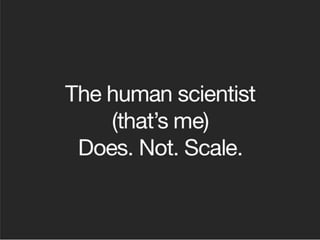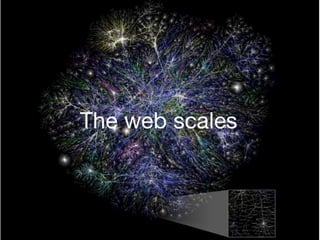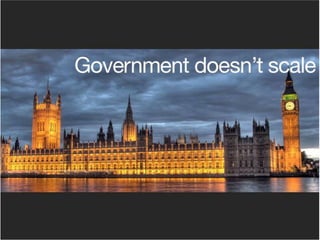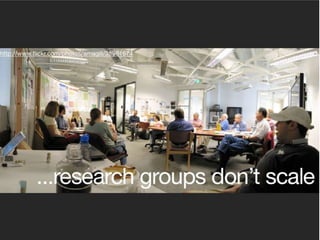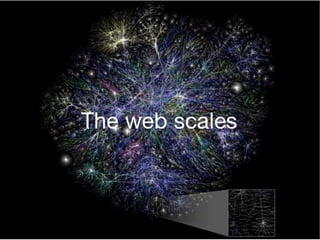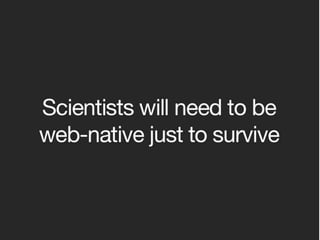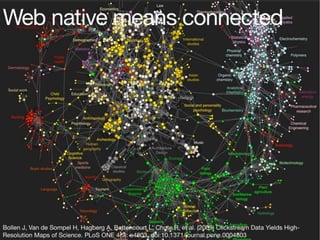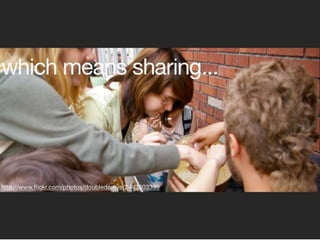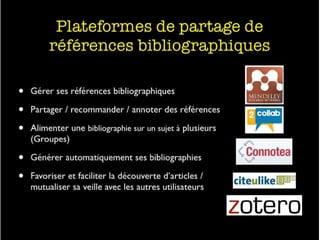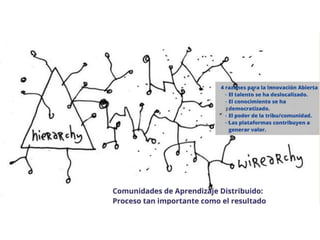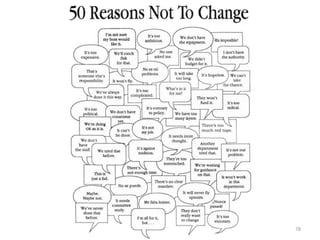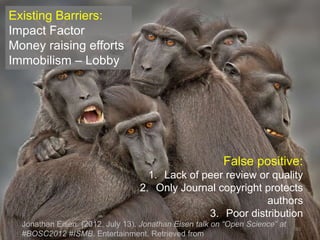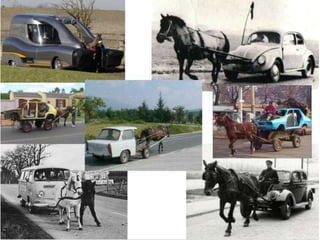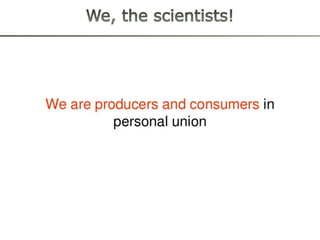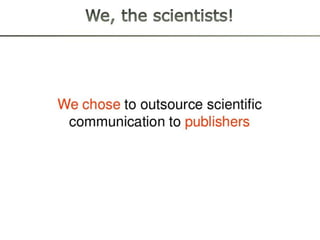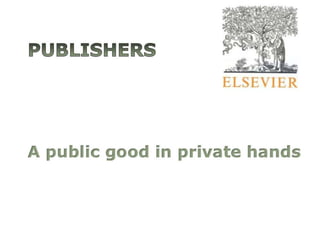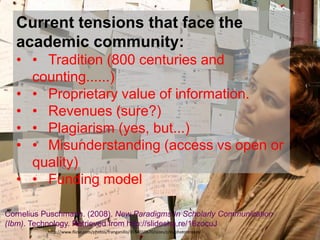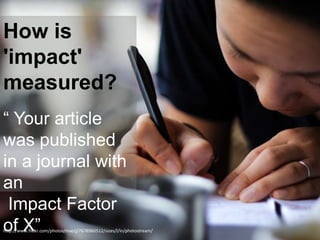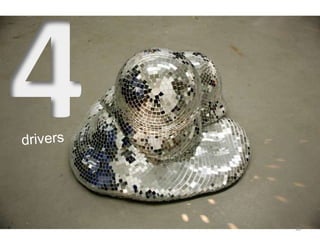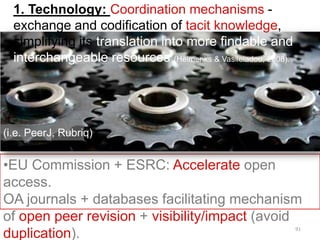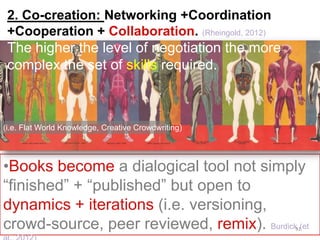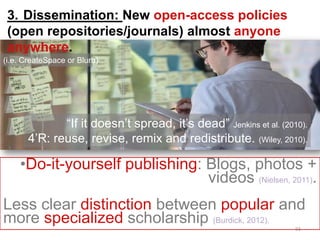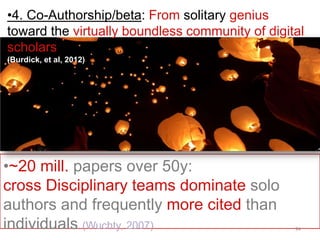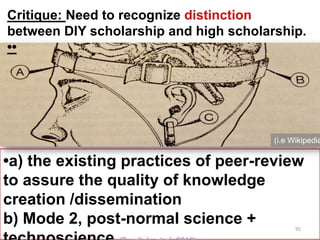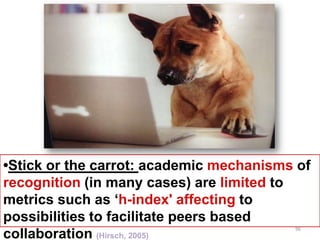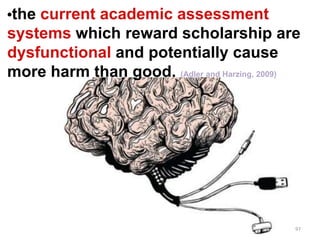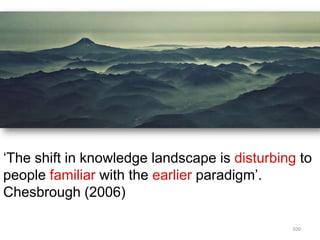digital scholarship: how open publication and co-creation could transform science
- 1. digital scholarship: how open publication and co-creation could transform science @cristobalcobo Oxford Internet Institute, Oxford University, England 1
- 2. 2
- 3. 3 JISC. (2012, September 4). Amberthomas openness he. Technology. Retrieved from http://slidesha.re/16znWvI
- 4. 6
- 5. 5
- 6. 4
- 7. 7
- 8. 10
- 9. 9
- 10. 11
- 11. 8
- 12. 13 Ron Mader. (2013, July 21). Set the default to open #openaccess #oer #openjournalism. Technology. Retrieved from http://slidesha.re/14BTtRN
- 13. 17
- 14. 28
- 15. 37 Cameron Neylon. (2011, July 4). Open Research: Pipedream or growing reality. Education. Retrieved from http://slidesha.re/16zm85S
- 16. 38
- 17. 39
- 18. 42
- 19. 43
- 20. 44
- 21. 45
- 22. 46
- 23. 47
- 24. 48
- 25. 49
- 26. 18 Source: Cameron Neylon. (2009, January 29). Open Access, Open Data. Open Research? Retrieved from http:// www.slideshare.net/CameronNeylon/open-access-open-data-open-research-presentation?from_search=1
- 27. 19
- 28. 20
- 29. 21
- 30. 22
- 31. 23
- 32. 24
- 33. 25
- 34. 26 Julien Sicot. (20131). Open Science, Open Access, Science2.0 : de nouvelles modalités pour... Technology. Retrieved from http://slidesha.re/14BSxNm
- 35. 29 Carl-Christian Buhr. (2012, October 22). Open Science at the European Commission. Technology. Retrieved from http://slidesha.re/14BTKEm
- 36. 30
- 37. Two features define an open-‐access publica3on: 1. Published contents are freely accessible through Internet. 2. Readers are given copyright permission to republish or reuse the content as they like so long as the author and publisher receive proper aOribu3on. Why Full Open Access Ma<ers What is open access? (that does not mean openly licensed) Public Domain All Rights Reserved Least restricAve à Most restricAve hOp://www.slideshare.net/mrgarin/o-‐a-‐w-‐e-‐e-‐k2009
- 38. 31
- 39. 32 john wilbanks. (2010, March 2). Nfais Wilbanks. News & Politics. Retrieved from http://slidesha.re/14BUs4o
- 40. 33
- 41. 34 Open data Open source software Open discussion Open resources Open review
- 42. Two relevant dimensions: knowledge generation (wikis, e-science, online education, distributed R&D, open innovation, open science, peer-based production, UGC) + new models of knowledge distribution (e-journals, open repositories, open licenses, dataweb archive). 50
- 43. ••Today's initiatives in cyber- infrastructure, e- Science, e-Humanities or e-Learning emerged from a period combining technological advances and economic-institutional redefinitions (Borgman, 2007) 51
- 44. •Exponential transformation of information is remarkable from the quantitative perspective, but also there fragmentation of mechanisms to create, access and distribute information. 52
- 45. ••New modes of scholarship of collaborative, trans-disciplinary and computationally engaged research, teaching and publication. (Burdick, et al, 2012). 53
- 46. •••Digital scholarship communities collaborate in dynamic, flexible/open-ended networks, exchanging in innovation, creativity/co-authoring. (i.e open Science Federation) 54
- 47. •Radical decentralization: Open values, ideology and potential of technologies born of peer-to- peer networking and wiki-ways. (Benkler, 2006) i.e. BioMed Central, Public Library of Science 55
- 48. connect supply and demand
- 49. Publishing journals Publishing books Post in conferences Blogging Tweeting DOAJ - OCW YouTube Channel Webinar Print-on-demand
- 50. First Monday: (1ST of its kind) 15-‐year-‐old open access journal about the internet. PLoS ONE: peer-‐reviewed, open-‐access resource from the Public Library Of Science
- 51. SciELO -‐ ScienAfic Electronic Library Online (1998): facilitate coopera3ve electronic publishing of scien3fic (peer review) journals. SiELO network (federa3on) is based on na3onal infrastructures (future sustainability). Goal: To foster the na3onal scien3fic research (expanding the visibility, accessibility and credibility) of the LA&C scien3fic publica3ons. SciElo enables: -‐ Searching, -‐ Preserving and -‐ Monitoring scien3fic literature. It includes over 760 journals, ~300,000 ar3cles. Impact factor: Over 6 million granted cita3on. Over than 12 million ar3cles accessed per month. SiELO: Compa3ble with interna3onal standards (Web of Science, Scopus, Crossref, Google Scholar, PubMed, DOAJ). 15 na3ons + South-‐South Coopera3on
- 53. 59 Source: Cameron Neylon. (2010, January 22). Science in the Open. Business & Mgmt. Retrieved from http://www.slideshare.net/CameronNeylon/science-in-the-open?from_search=2
- 54. 60
- 55. 62
- 56. 63
- 57. 64
- 58. 65
- 59. 66
- 60. 68
- 61. 69
- 62. 70
- 63. 71
- 64. 72
- 65. 73
- 66. 74
- 68. 78
- 70. 80 Jonathan Eisen. (2012, July 13). Jonathan Eisen talk on “Open Science at #BOSC2012 #ISMB. Entertainment. Retrieved from http://slidesha.re/16znpdq Existing Barriers: Impact Factor Money raising efforts Immobilism ‒ Lobby False positive: 1. Lack of peer review or quality 2. Only Journal copyright protects authors 3. Poor distribution
- 71. 81
- 72. 82 Björn Brembs. (2011, August 30). What s wrong with scholarly publishing today? II. Business & Mgmt. Retrieved from http://slidesha.re/14BT7L5
- 73. 83
- 74. 84
- 75. 85
- 76. 86 Where you publish is more important to us than what you publish “Not everything that can be counted counts, and not everything that counts can be counted
- 77. 35
- 78. 87 Current tensions that face the academic community: • • Tradition (800 centuries and counting......) • • Proprietary value of information. • • Revenues (sure?) • • Plagiarism (yes, but...) • • Misunderstanding (access vs open or quality) • • Funding model hOp://www.flickr.com/photos/franganillo/3554010670/sizes/z/in/photostream/ Cornelius Puschmann. (2008). New Paradigms In Scholarly Communication (Ibm). Technology. Retrieved from http://slidesha.re/16zocuJ
- 79. 88 How is 'impact' measured? “ Your article was published in a journal with an Impact Factor of X hOp://www.flickr.com/photos/macrj/7678960512/sizes/l/in/photostream/
- 80. 89 How could 'impact' be measured? Authority 3.0 (Michael Jensen) • • X citations (de-duped from Google Scholar, Scopus, WoSc) • • prestige of the publisher + peer pre-reviewers, commenters • • citations (scholarly, hyperlinks, social bookmarks) • • expert ratings (f1000.com; Peer Reviewers) • • community rating& commenting (Digging; Rating) • • social media coverage (bookmarked/discussed/commented) • • it was viewed X times in X journal/communities • • proportion-quoted-by-others: out in Web/ valued-links • • author's participation in other valued projects • • inclusion in in syllabi and other indexes Authority 2.0 and 3.0 (PDF) originally presented at 50th anniversary celebra3on of Hong Kong University Press, 11/2006. hOp://bit.ly/17jDV1f Björn Brembs. (2009, January 21). Reputation, authority and incentives. Or: How to get rid of the Imp... Retrieved from http://slidesha.re/16zoylf
- 81. drivers 90
- 82. •EU Commission + ESRC: Accelerate open access. OA journals + databases facilitating mechanism of open peer revision + visibility/impact (avoid duplication). 1. Technology: Coordination mechanisms - exchange and codification of tacit knowledge, simplifying its translation into more findable and interchangeable resources (Heimeriks & Vasileiadou, 2008). (i.e. PeerJ, Rubriq) 91
- 83. •Books become a dialogical tool not simply “finished + “published but open to dynamics + iterations (i.e. versioning, crowd-source, peer reviewed, remix). Burdick (et al., 2012) 2. Co-creation: Networking +Coordination +Cooperation + Collaboration. (Rheingold, 2012) The higher the level of negotiation the more complex the set of skills required. (i.e. Flat World Knowledge, Creative Crowdwriting) 92
- 84. •Do-it-yourself publishing: Blogs, photos + videos (Nielsen, 2011). Less clear distinction between popular and more specialized scholarship (Burdick, 2012). 3. Dissemination: New open-access policies (open repositories/journals) almost anyone anywhere. “If it doesn t spread, it s dead Jenkins et al. (2010). 4 R: reuse, revise, remix and redistribute. (Wiley, 2010). (i.e. CreateSpace or Blurb) 93
- 85. •~20 mill. papers over 50y: cross Disciplinary teams dominate solo authors and frequently more cited than individuals (Wuchty, 2007) •4. Co-Authorship/beta: From solitary genius toward the virtually boundless community of digital scholars (Burdick, et al, 2012)). 94
- 86. •a) the existing practices of peer-review to assure the quality of knowledge creation / dissemination b) Mode 2, post-normal science + technoscience (Burdick, et al, 2012). Critique: Need to recognize distinction between DIY scholarship and high scholarship. •• (i.e Wikipedia) 95
- 87. •Stick or the carrot: academic mechanisms of recognition (in many cases) are limited to metrics such as h-index' affecting to possibilities to facilitate peers based collaboration (Hirsch, 2005) 96
- 88. •the current academic assessment systems which reward scholarship are dysfunctional and potentially cause more harm than good. (Adler and Harzing, 2009) 97
- 89. Due to these elements of exclusiveness/ individualism, knowledge-sharing in academic organizations are often inefficient (Seonghee and Boryung, 2008) The highly competitive environment enhance lack of partnership (Kanwar, Kodhandaraman, and Umar, 2010). 98
- 90. Will universities institutionalize approaches (learning and research) grounded in collaboration instead of celebrity and competition? 99
- 91. The shift in knowledge landscape is disturbing to people familiar with the earlier paradigm . Chesbrough (2006) 100
- 92. •More appropriate institutional recognition are needed (i.e. A tenure evaluation system that recognizes the value of more flexible mechanisms of knowledge creation and new publication formats). Is not easy to determine to what extent traditional and new practices of scholarship will coexist. (i.e. Reinventing Discovery) 101
- 93. Appropriating these tools/practices requires a new set of skills (i.e. Curation, Editing, and Modelling) to work across an information ecosystem full of new intermediaries. 102
- 94. New cultural practices: institutional flexibility (i.e. diversifying tenure track, re- understand concepts such as academic visibility or digital influence). 103
- 95. 104
- 96. 105 Sources Cameron Neylon. (2010, January 22). Science in the Open. Business & Mgmt. Retrieved from hOp://www.slideshare.net/ CameronNeylon/science-‐in-‐the-‐open?from_search=2 Cameron Neylon. (2009, January 29). Open Access, Open Data. Open Research? Retrieved from hOp://www.slideshare.net/ CameronNeylon/open-‐access-‐open-‐data-‐open-‐research-‐presenta3on?from_search=1 Julien Sicot. (2013, May 21). Open Science, Open Access, Science2.0 : de nouvelles modalités pour... Technology. Retrieved from hOp://www.slideshare.net/jsicot/open-‐science-‐open-‐access-‐science20-‐de-‐nouvelles-‐modalits-‐pour-‐la-‐communica3on-‐ scien3fique?from_search=3 Björn Brembs. (2011, August 30). What’s wrong with scholarly publishing today? II. Business & Mgmt. Retrieved from hOp:// slidesha.re/14BT7L5 Ron Mader. (2013, July 21). Set the default to open #openaccess #oer #openjournalism. Technology. Retrieved from hOp:// slidesha.re/14BTtRN Carl-‐Chris3an Buhr. (2012, October 22). Open Science at the European Commission. Technology. Retrieved from hOp://slidesha.re/ 14BTKEm John Wilbanks. (2010, March 2). Nfais Wilbanks. News & Poli3cs. Retrieved from hOp://slidesha.re/14BUs4o Cameron Neylon. (2011, July 4). Open Research: Pipedream or growing reality. Educa3on. Retrieved from hOp://slidesha.re/ 16zm85S Jonathan Eisen. (2012, July 13). Jonathan Eisen talk on “Open Science” at #BOSC2012 #ISMB. Entertainment. Retrieved from hOp:// slidesha.re/16znpdq JISC. (2012, September 4). Amberthomas openness he. Technology. Retrieved from hOp://slidesha.re/16znWvI Cornelius Puschmann. (2008). New Paradigms In Scholarly CommunicaRon (Ibm). Technology. Retrieved from hOp://slidesha.re/ 16zocuJ Björn Brembs. (2009, January 21). ReputaRon, authority and incenRves. Or: How to get rid of the Imp... Retrieved from hOp:// slidesha.re/16zoylf
- 98. @cristobalcobo hOp://3ny.cc/ppts Oxford Internet Ins3tute Research Fellow. 106
- 99. 107
- 100. 108
Editor's Notes
- #16: Carroll MW (2011) Why Full Open Access Matters. PLoSBiol 9(11): e1001210. doi:10.1371/journal.pbio.1001210
- #17: Spanish, English, French, and Germangeneration of knowledge is increasingly linked through outcome measures(International Index) Web of Science, Scopus, Crossref, Google Scholar, PubMed, DOAJ, LILACShttp://www.slideshare.net/AndySanIs/scielo-10434345http://www.bth.se/elpub99/ap.nsf/08c6c2f88424ad99c12566ff002a0c10/a4123207d712fcbdc12566ff00379958/$FILE/268-279.pdfhttp://www.latindex.unam.mx/noticias/resNotHis.html?id=176
- #28: Directory of Open Access Journals (120) > To increase the visibility and ease of use of open access scientific and scholarly journals thereby promoting their increased usage and impact. .. cover all open access scientific and scholarly journals that use a quality control system to guarantee the content (peer-review or editorial quality control ).Open Access Journal: “…journals that use a funding model that does not charge readers or their institutions for access."open access" we take the right of users to "read, download, copy, distribute, print, search, or link to the full texts of these articles" as mandatory for a journal to be included in the directory. Research Journal: Journals that report primary results of research or overviews of research results to a scholarly community. - SOURCE: http://www.doaj.org/doaj?func=loadTempl&templ=about&uiLanguage=enFirst Monday:one of the first openly accessible, peer–reviewed journals on the Internet, solely devoted to the Internet. Since its start in May 1996, First Monday has published 1,153 papers in 184 issues, written by 1,502 different authors. In addition, nine special issues have appeared. http://firstmonday.org/htbin/cgiwrap/bin/ojs/index.php/fm/about/editorialPolicies#focusAndScope
- #57: http://www.slideshare.net/jisc_bce/knowledge-transfer-20


